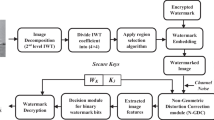Abstract
This paper presents spatial steganography scheme based on adaptive group modification (AGM) (Rad et al. in Signal Process 125:315–328, 2016). First we study AGM. Then we criticize and improve it. AGM works based on embedding segments of secret message bits on triplet of prediction errors. It also employs multilayer embedding mechanism to increase the capacity. We have improved it by exploiting more number of host bins to increase the hiding capacity. Furthermore, by changing the procedure of secret message segmentation and altering modification groups of prediction errors, the proposed method preserves the same stego image quality. Moreover, the required side information for correct extraction is 32 bit (too much less than the one required for AGM). The experimental results confirm that the proposed method increases the embedding capacity up to 22 K bits while PSNR (peak signal to noise ratio) almost remains the same in comparison with AGM method. Also, the results prove that the proposed method outperforms recent methods.











Similar content being viewed by others
References
Alattar, A. M. (2004). Reversible watermark using the difference expansion of a generalized integer transform. IEEE Transactions on Image Processing, 13(8), 1147–1156.
Al-Qershi, O. M., & Khoo, B. E. (2011). High capacity data hiding schemes for medical images based on difference expansion. Journal of Systems and Software, 84(1), 105–112.
Celik, M. U., Sharma, G., Tekalp, A. M., & Saber, E. (2005). Lossless generalized-LSB data embedding. IEEE Transactions on Image Processing, 14(2), 253–266.
Cheddad, A., Condell, J., Curran, K., & Mc Kevitt, P. (2010). Digital image steganography: Survey and analysis of current methods. Signal Processing, 90(3), 727–752.
Fallahpour, M., & Sedaaghi, M. H. (2007). High capacity lossless data hiding based on histogram modification. IEICE Electronics Express, 4(7), 205–210.
Fridrich, J., Goljan, M., & Rui, D. (2002). Lossless data embedding: New paradigm in digital watermarking. EURASIP Journal on Applied Signal Processing, 2002(1), 185–196.
Fu, D.-S., Jing, Z.-J., Zhao, S.-G., & Fan, J. (2014). Reversible data hiding based on prediction-error histogram shifting and EMD mechanism. AEU-International Journal of Electronics and Communications, 68(10), 933–943.
Govind, P. V. S., Sajila, M. K., & Varghese, B. M. (2016). A two stage data hiding scheme with high capacity based on interpolation and difference expansion. Procedia Technology, 24, 1311–1316.
Hiary, S., Jafar, I., & Hiary, H. (2017). An efficient multi-predictor reversible data hiding algorithm based on performance evaluation of different prediction schemes. Multimedia Tools and Applications, 76(2), 2131–2157.
Hong, W., Chen, T.-S., & Shiu, C.-W. (2009). Reversible data hiding for high quality images using modification of prediction errors. Journal of Systems and Software, 82(11), 1833–1842.
Lee, C.-F., Chen, H.-L., & Tso, H.-K. (2010). Embedding capacity raising in reversible data hiding based on prediction of difference expansion. Journal of Systems and Software, 83(10), 1864–1872.
Leung, H. Y., Cheng, L. M., Liu, F., & Fu, Q. K. (2013). Adaptive reversible data hiding based on block median preservation and modification of prediction errors. Journal of Systems and Software, 86(8), 2204–2219.
Li, X., Yang, B., & Zeng, T. (2011). Efficient reversible watermarking based on adaptive prediction-error expansion and pixel selection. IEEE Transactions on Image Processing, 20(12), 3524–3533.
Li, X., Zhang, W., Gui, X., & Yang, B. (2013). A novel reversible data hiding scheme based on two-dimensional difference-histogram modification. IEEE Transactions on Information Forensics and Security, 8(7), 1091–1100.
Ma, X., Pan, Z., Sen, H., & Wang, L. (2015). High-fidelity reversible data hiding scheme based on multi-predictor sorting and selecting mechanism. Journal of Visual Communication and Image Representation, 28, 71–82.
Ni, Z., Shi, Y.-Q., Ansari, N., & Wei, S. (2006). Reversible data hiding. IEEE Transactions on Circuits and Systems for Video Technology, 16(3), 354–362.
Pan, Z., Sen, H., Ma, X., & Wang, L. (2015). Reversible data hiding based on local histogram shifting with multilayer embedding. Journal of Visual Communication and Image Representation, 31, 64–74.
Qian, Z., Zhang, X., & Wang, S. (2014). Reversible data hiding in encrypted JPEG bitstream. IEEE Transactions on Multimedia, 16(5), 1486–1491.
Rad, R. M., Wong, K. S., & Guo, J.-M. (2014). A unified data embedding and scrambling method. IEEE Transactions on Image Processing, 23(4), 1463–1475.
Rad, R. M., Wong, K. S., & Guo, J.-M. (2016). Reversible data hiding by adaptive group modification on histogram of prediction errors. Signal Processing, 125, 315–328.
The USC-SIPI image database (1977).
Tian, J. (2003). Reversible data embedding using a difference expansion. IEEE Transactions on Circuits and Systems for Video Technology, 13(8), 890–896.
Weng, S., Liu, Y., Pan, J.-S., & Cai, N. (2016a). Reversible data hiding based on flexible block-partition and adaptive block-modification strategy. Journal of Visual Communication and Image Representation, 41, 185–199.
Weng, S., Pan, J., & Li, L. (2016b). Reversible data hiding based on an adaptive pixel-embedding strategy and two-layer embedding. Information Sciences, 369, 144–159.
Weng, S. W., Zhao, Y., Ni, R. R., & Pan, J. S. (2009). Parity-invariability-based reversible watermarking. Electronics Letters, 45(20), 1022–1023.
Yip, S.-K., Au, O.C., Wong, H.-M., & Ho, C.-W. (2006). Generalized lossless data hiding by multiple predictors. In 2006 IEEE international symposium on circuits and systems, 2006. ISCAS 2006. Proceedings (pp. 4–pp). IEEE.
Zhang, X. (2013). Reversible data hiding with optimal value transfer. IEEE Transactions on Multimedia, 15(2), 316–325.
Zhao, Z., Luo, H., Zhe-Ming, L., & Pan, J.-S. (2011). Reversible data hiding based on multilevel histogram modification and sequential recovery. AEU-International Journal of Electronics and Communications, 65(10), 814–826.
Author information
Authors and Affiliations
Corresponding author
Additional information
Publisher's Note
Springer Nature remains neutral with regard to jurisdictional claims in published maps and institutional affiliations.
Rights and permissions
About this article
Cite this article
Jabbari, F., Sedaaghi, M.H. Adaptive multilevel technique based on histogram shifting for reversible data hiding. Multidim Syst Sign Process 30, 1563–1581 (2019). https://doi.org/10.1007/s11045-018-0617-x
Received:
Revised:
Accepted:
Published:
Issue Date:
DOI: https://doi.org/10.1007/s11045-018-0617-x




